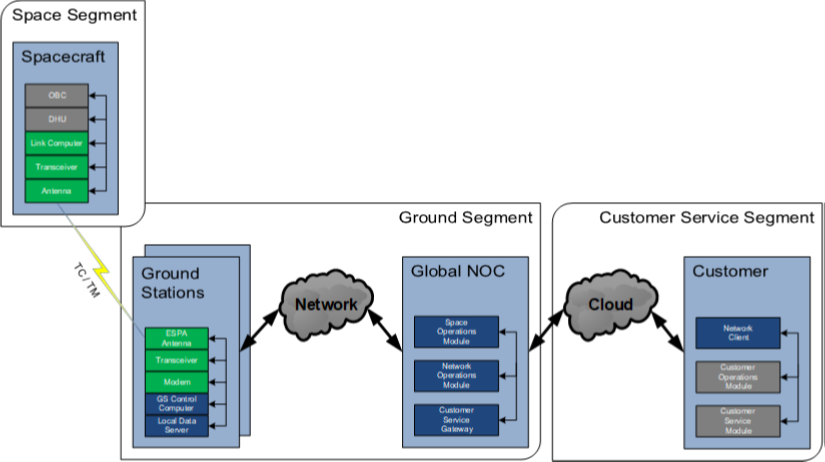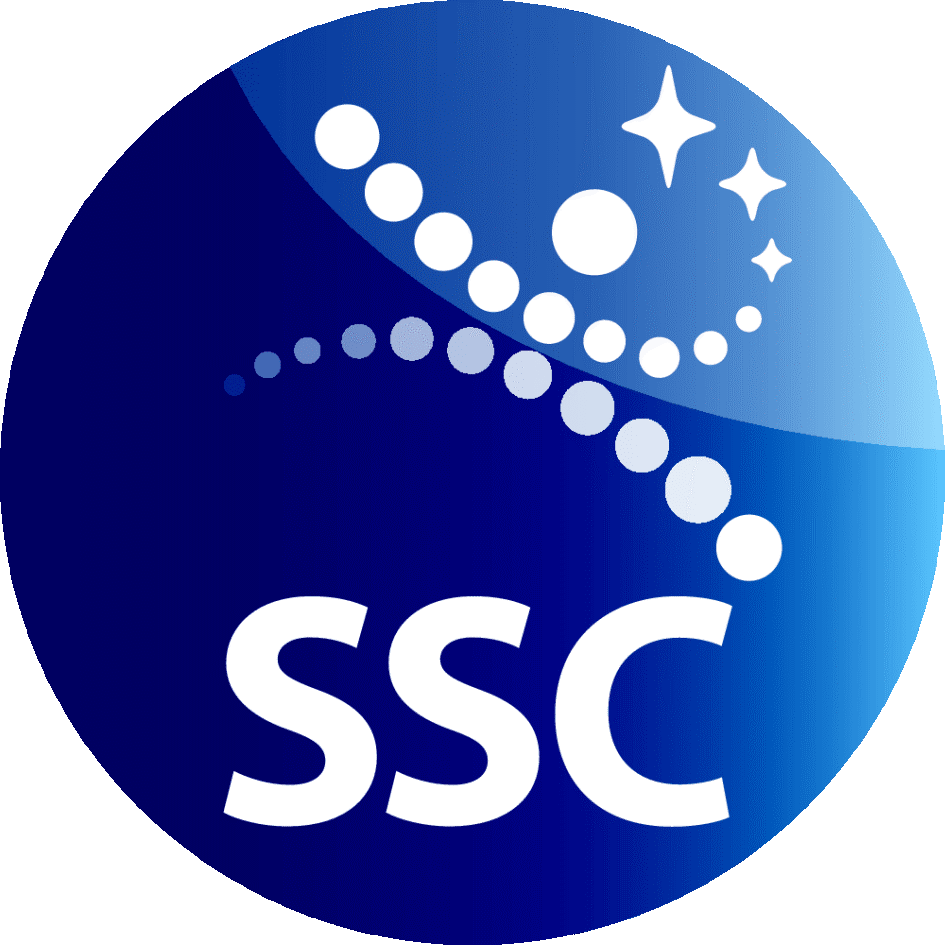-
StatusOngoing
-
Status date2023-03-28
-
Activity Code6B.086
The commercial advancements in low-cost space segment have addressed some of the challenges in the NewSpace market. But there remain other prominent obstacles evident in the ground communications segment that are still not sufficiently addressed.
Global NewSpace Network Evolution (GNNetE) aims to provide a comprehensive innovative solution addressing some of the key constraints listed below,
| Constraint | Description | GNNetE Objective |
|---|---|---|
| Spectrum Availability | Limited availability of narrowband channels leads to an extensive process in acquiring licenses and frequency allocation. This often results in lengthy waiting periods and, in many cases, to a “no license” being allocated due to shortage of available channels. | Use of spread spectrum is being investigated as an optional design element to benefit spectrum sharing. |
| Multiple spacecraft access to ground network | With more constellations being launched, the conventional technology requiring a dedicated antenna resource to track a satellite over the entire pass is not efficient. Technological advancements are imperative to serve multiple satellites simultaneously with a single antenna. | Beamforming antennas with the capability to serve multiple satellites simultaneously. |
| Constellation Operations | It is uneconomical to manually monitor and manage each spacecraft in the age of evolving constellations. | Development of automated spacecraft operations. |
| Cost Efficiency |
When all the above parameters are considered, there is no currently available solution to accommodate the cost in a competitive level. | Integrate all the technologies under a Network Operations Centre to provide a technically and economically viable solution. |
The major challenge of the GNNetE project was to address the regulatory conditions as defined today. Wider bandwidths are imperative to exploit the benefits of spread spectrum without causing interference to adjacent or shared users. The choice of spectrum needs to address the NewSpace market as well as not impede the development and future use of the next generation networks.
The novel architecture and onboard Link Computer demanded the system to be compatible with existing communication protocols and serve a diverse range of spacecraft with variable limitations on power and mass budgets.
Since the proposed system is likely to become a major enabler for the industry growth and a facilitator to the regulators for managing the spectrum it was essential to offer a technologically advanced solution that is both economically and technically attractive.
Global NewSpace Network Evolution (GNNetE) is committed to offering a comprehensive and innovative economical solution to address the current challenges in the NewSpace market segment. Some of the key product benefits the overall system can offer are highlighted below.
More efficient use of spectrum – Through the development of a robust system that utilizes techniques developed for the terrestrial mobile communications systems, a better sharing of spectrum can be achieved accommodating the rapid growth in constellations.
Robust spacecraft communications with automated link management – The Link Computer offers an advanced architecture that connects the spacecraft seamlessly to the network and manages all aspects of negotiations and link establishment with the network. The Link Computer onboard the spacecraft can interface with the satellite OBC and/or the DHU.
Significantly lower cost ground segment solution – The introduction of electronically steerable beam forming antennas, enables simultaneous communications with multiple spacecraft whilst it significantly reduces the installation and maintenance costs of the system. As a result, the end user benefits from cost improvements through the sharing of the antenna but also through the reduced operational costs. Coupled with SDN principles the conventional RF infrastructure can be replaced with network functions to facilitate a low-cost solution to the customer.
Constellation optimized architecture – The Link Computer facilitates automating the link/network connection and the management of the functional parameters of the spacecraft requiring minimum human intervention. This provides cost benefits to constellation operators due to the exploitation of automation and less dependency on manpower.
The GNNetE system, designed to offer an end-to-end solution required compatible specifications of both the space and ground segments. The definition phase was successful in defining the service offerings for GNNetE considering the requirements of the customers and the NewSpace market constraints.
The top-level product offerings from GNNetE, and its main sub-systems is shown in the figure below. Products highlighted in grey are included for completeness of the offering and do not form part of the GNNetE offering.

Elements of the proposed GNNetE products will be grouped together to serve the two key product offerings – “Network Operations Service” and “Spacecraft Operations Service” a secondary service offering.
The GNNetE network operations, which is the core product offering delivers a pivotal technological advancement in terms of providing cost-effective high-performance ground segment for NewSpace constellations through a multiple access antenna solution providing both TT&C and Payload Telemetry (mission data) downlink services. Embarking on Software Defined Networking (SDN) principles, the conventional RF functions at the gateway can be performed on virtualised network functions (VNF) thereby offering a completely integrated gateway. The integrated gateway shall be broadly deployable and scales through proven industry infrastructure, interfaces, and frameworks.
The spacecraft operations service focusses on autonomous constellation operations benefitting from cost reductions favoured by operating within a virtualised, scalable, constellation environment allowing sensitive mission applications to utilise and benefit from the advanced GNNetE features while securely managing their own operations.
SSC Space UK Ltd aimed to develop an offering that targets the communications and operations of Nano/small satellites and constellations. The service offerings described above collectively will enable a market proposition that is attractive, both financially and technically, to the NewSpace market segment.
The definition phase focussed on specifying the most advanced and innovative NewSpace ground solution through GNNetE. The definition phased emphasised on defining specifications for the below imperative developments.
-
Telecommunications link management
-
K/Ka-Band Spacecraft Radio
-
Integrated gateway terminal
-
Virtualised ground network
The definition phase of the project investigated the current technological advancements in each of the contributing elements compliant to the derived system and subsystem requirements. Evaluation and trade off analysis on available technologies were performed to define the most technically advanced and economically viable solution to the NewSpace market.
Incorporating the specifications defined and the whole service offering for GNNetE, figure below shows the top level GNNetE system architecture.

The GNNetE ground segment embraced novel approaches to beamforming techniques and waveforms to provide the most technically advanced solution to the market. Adoption of spreading techniques currently employed in the terrestrial mobile network were investigated and technical merits evaluated. Technical and RF specifications for the SDR and transceiver units were defined to provide an end-to-end solution.
The project plan for GNNetE definition phase identified the key product requirements and defined the work package details for each GNNetE element. Key personnel responsible for each of the work packages were identified and resources were allocated to successful completion of the work package tasks. Work package descriptions for each of the identified scope of work detailed the tasks to be completed and defined the deliverables for each task. All the defined deliverables agreed was delivered on each of the review milestones during the definition phase. Technical and commercial risks were assessed with appropriate mitigation techniques adopted.
Table below shows the milestone review dates that were successfully completed during the definition phase.
| Review Milestone | Milestone Completion | Deliverables Submitted |
|---|---|---|
| Requirements Review | 15/12/2020 | Yes |
| Mid-Term Review | 18/03/2021 | Yes |
| Phase Completion Review | 28/04/2021 | Yes |
The GNNetE program successfully completed the definition phase defining the core end-to-end service offerings addressing the NewSpace constraints – Network Operations and a secondary Spacecraft Operations.
The definition phase of the project identified the target market segments for GNNetE services and developed a long-term business plan. Based on the key market and system requirements, specifications were identified and defined for the space and ground segment subsystems. Trade off analysis and novel approaches to beamforming techniques and waveforms were also investigated to provide the most technically advanced solution. The technical merits of offering a spread spectrum solution were thoroughly explored to successfully address the current NewSpace regulatory constraints.
The definition phase was successfully closed on 28/04/2021 with the aim of progressing into development phase.



